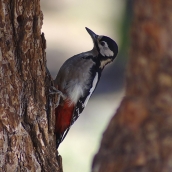Great Spotted Woodpecker (Dendrocopos major)
The great spotted woodpecker measures 22-23 cm in total length and has a wingspan of 34-39 cm; it is the only woodpecker that breeds in Macaronesia. Dorsal plumage is black and white, and the underparts are white-brown with a red patch under the tail. Sexual dimorphism is readily apparent in that the male has a red patch on the rear of the head, which is absent in the female. Juveniles are distinguished by their red crown. The relatively long stiff tail helps the bird climb up and down tree trunks. The legs are also adapted to tree-living, as the feet have two toes pointing forward and two toes pointing back. During the breeding season, the birds beat their bills against the tree trunk, producing a drumming sound that can be heard far away. In Macaronesia, the woodpecker is only present in the Canaries, where there are two subspecies: D. m. thanneri, in Gran Canaria, and D. m. canariensis, in Tenerife. However, recent genetic studies point to the existence of a single species in the islands. The woodpecker lives almost exclusively in forests of Canary pine (Pinus canariensis), although it has adapted to plantations of Pinus radiata and to other trees, such as the chestnut (Castanea sativa), more so in Gran Canaria than in Tenerife. Additionally, the woodpecker is far more abundant in Gran Canaria (probably fewer than 1,000 breeding pairs) than in Tenerife (around 200 pairs), despite its continuing expansion in the latter. It feeds mainly on insects and larvae, which it catches in tree bark, but also consumes Canary Pine seeds, various fruits and food remains in recreational areas; on occasion, it can prey on the chicks of the African blue tit (Cyanistes teneriffae). It breeds in nests placed in holes dug out of dead pine, or other, trees and even in specimens of Chamaecytisus proliferus, generally at 5-8m off the ground. A clutch of 2-5 eggs is laid from April to May, and the chicks leave the nest in June-July. The main threats to this woodpecker and its habitat are forest fires, the disappearance of sources of water and human interference with the most exposed nests, particularly those located in recreational areas. Fortunately, virtually all of its distribution area falls within the confines of protected natural areas, and the current practice of clearing pine forests benefits this species.













